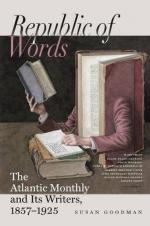These three stereographs were sent us by a lady now residing in Charleston. The Battery, the famous promenade of the Charlestonians, since armed with twenty-four-pounders facing Fort Sumter; the interior of Fort Moultrie, with the guns spiked by Major Anderson; and a more extensive view of the same interior, with the flag of the seven stars, (corresponding to the seven deadly sins,)—the free end of it tied to a gun-carriage, as if to prevent the winds of the angry heaven from rending it to tatters. In the distance, to the right, Fort Sumter, looking remote and inaccessible,—the terrible rattle which our foolish little spoiled sister Caroline has insisted on getting into her rash hand. How ghostly, yet how real, it looms up out of the dim atmosphere,—the guns looking over the wall and out through the embrasures,—meant for a foreign foe,—this very day (April 13th) turned in self-defence against the children of those who once fought for liberty at Fort Moultrie! It is a sad thought that there are truths which can be got out of life only by the destructive analysis of war. Statesmen deal in proximate principles,—unstable compounds; but war reduces facts to their simple elements in its red-hot crucible, with its black flux of carbon and sulphur and nitre. Let us turn our back on this miserable, even though inevitable, fraternal strife, and, closing our eyes for an instant, open them in London.
Here we are at the foot of Charing Cross. You remember, of course, how this fine equestrian statue of Charles I. was condemned to be sold and broken up by the Parliament, but was buried and saved by the brazier who purchased it, and so reappeared after the Restoration. To the left, the familiar words “Morley’s Hotel” designate an edifice about half windows, where the plebeian traveller may sit and contemplate Northumberland House opposite, and the straight-tailed lion of the Percys surmounting the lofty battlement which crowns its broad facade. We could describe and criticize the statue as well as if we stood under it, but other travellers have done that. Where are all the people that ought to be seen here? Hardly more than three or four figures are to be made out; the rest were moving, and left no images in this slow, old-fashioned picture,—how unlike the miraculous “instantaneous” Broadway of Mr. Anthony we were looking at a little while ago! But there, on one side, an omnibus has stopped long enough to be caught by the sunbeams. There is a mark on it. Try it with a magnifier.
Charing
Strand
633.
Here are the towers of Westminster Abbey. A dead failure, as we well remember them,—miserable modern excrescences, which shame the noble edifice. We will hasten on, and perhaps by-and-by come back and enter the cathedral.




